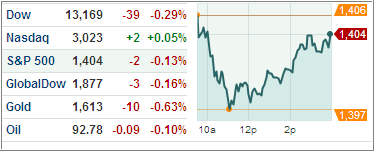US equties mostly declined Monday after six straight up sessions as weak Japanese Q2 GDP reading weighed on investors despite a successful auction of Italian bonds that somewhat eased market concerns on Europe.
Both the S&P 500 and the Dow Industrials ended the day modestly lower as investors rushed to take profits while the NASDAQ recovered from early losses to finish slightly higher ahead of tomorrow’s retail sales data for July.
However, trading volume on the NYSE has now reached downright absurd low levels by hitting its lowest non-Holiday figure in over a decade! This means that any movement in the indexes can be easily manipulated by those still playing the game hoping that none of the bad news matters, such as lower earnings guidance, and slipping company revenues. Why? Because at some time the central banks are expected to serve another helping of QE, which is supposed put a floor under the market and keep traders happy. This will work until the day that it doesn’t.
US Treasuries closed flat, paring early gains after Italy successfully raised EUR 8 billion in one-year securities today while Germany auctioned six-month notes at record low yields that tamed market fears the Euro crisis is worsening.
The euro lost ground against the greenback in today’s session with the EUR/USD pair dropping to 1.2341 from the day’s high of 1.2287 after media reports suggested another lawsuit has been filed in Germany challenging the constitutional validity of Europe’s bailout funds.
The dollar index, a measure of the greenback’s strength against its six global peers, had tumbled to 82.404 from 82.541 Friday. The new suit could push back a ruling expected on September 12 considered critical for EU’s debt crisis.
European stock markets dropped after heavyweight resource firms tanked, dragging stocks lower. Italian banks however, managed to buck the trend after Rome successfully raised 8 billion euros in government bond auctions. Banks in France also advanced while resource stocks pulled the market lower in the UK. Carmakers weighed on the German benchmark, dragging the DAX 30 index down 0.5 percent.
The yield on Spanish 10-year bonds dropped seven basis points to 6.84 percent while yield on similar maturity Italian bonds declined six basis points to 5.84 percent on hopes the European Central Bank will intervene soon to keep borrowing costs under check.
Within the ETF universe, the iShares MSCI Israel Capped Investable Market Index Fund (EIS) tanked 4.96 percent over reports of possible conflict in the Middle-East.
Also, the ProShares VIX Short-Term Futures ETF (VIXY) tumbled 2.67 percent after the so-called fear-tracking CBOE Volatility Index slumped 7.1 percent on improved risk sentiment. The Invesco PowerShares DB Agriculture Fund (DBA) shed 1.37 percent in today’s session after corn and soybean futures slumped.
Disclosure: No holdings
Contact Ulli

Comments 2
Hi Uli Just a question What is your impression of the Low Volitility ETF’s introduced last year? They are having a marvelous runup as I can see. SPLV & EEMV have made large jumps this yr alone. I looked and did not find the 6 new funds in your tables but that is possibly my fault for looking too fast.
ciao Frank B
Frank,
Yes, the use of low volatility ETFs can be extremely valuable in that you can avoid the sell stop trigger occasionally. I especially like SPLV, which has done better than its index, and I will add it to the data base, since it now features sufficient volume.
Personally, in my advisor practice, I have preferred lower volatility products this year. For example, while my preference has been model portfolio #2, I had substituted DVY for VTI for many clients with the result that we never got stopped out and therefore have handled the usual market fluctuations much better. Actually, when you chart the S&P, DVY and SPLV, you will see that the less volatile of the 3 have outperformed the index. While I don’t own SPLV at this time, I may very well make it a part of some of the model portfolios in the future.
Ulli…